Ebony: The Dark Outlook For Dark Woods

ARTICLE SOURCE: The Wood Database
Whether conscious of it or not, just about the entire world loves dark colored woods—and the darker, the better. So, what happens when you mix a strong global demand with small and slow-growing trees?
Issues
Consider these words by the co-founder of Taylor Guitars in his talk on ebony back in 2012, who articulates the issue very well:
“Ebony has been a wood that for two, or three, or four hundred years, we’ve gone into countries, and we’ve used the ebony until it’s all gone. Literally. Then we move into another country, and we take their ebony till it’s all gone. Why do I say ‘we’?—because ebony isn’t cut in Africa for use by Africans. Ebony is cut in Africa to be sold to people like us, to make things like guitars out of. That’s the simple truth of the matter.”
-Bob Taylor
WHY SHOULD I CARE?
Maybe you shouldn’t. But at the very least, everyone who buys, uses or makes ebony wood products should be aware of the situation, and make informed, conscientious decisions. Maybe you’ve only used a little bit of ebony here and there, but just remember this: the world is filled with small bits and pieces of ebony. This is precisely what ebony is used for. No one is going to make an enormous office table out of solid ebony, but that same office table may very well feature a custom inlay made of ebony. More often than not, ebony is used bit by bit, and you might be the one using that next bit.
(On a personal note, I am a woodworker myself, and yes, I have bought and used ebony for a variety of projects in the past. Was I aware of the scope of the situation surrounding ebony at the time? No. Knowing what I know now, would I still buy and use ebony? Maybe… but I would definitely think twice before I went ahead with it for a project. See alternatives below.)
THE ISSUE
The issue isn’t rocket science: ebony trees (in the Diospyros genus) are generally small and slow growing. Demand for ebony wood is very high: it’s a high quality hardwood that’s very hard, very strong, and most of all, very black. Low supply and high demand means prices go way up. These high prices, coupled with the fact that a lot of the world’s ebony grows in third-world countries, only exacerbates the problem. (Take, for example, the illegal logging that occurred in Madagascar, especially in the early 2000s, where people were literally risking life and limb to get rosewood and ebony logs smuggled out from protected national parks.)
Ideally, most modern industrialized nations harvest wood in such a way that it is sustainable. Certain areas are logged at certain rates to ensure that there will still be trees around to harvest and use for tomorrow. But given ebony’s slow growth rate, and the current rate of harvest, it’s easy to see why there’s a dark outlook for these dark woods.
THE LINEUP
Let’s take a look at the particular species of ebony and other dark woods and their conservation status:
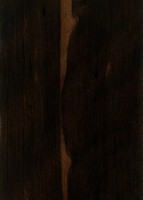 |
Ceylon Ebony (Diospyros ebenum)
STATUS: EXPORTS BANNED Still commonly referred to as Ceylon Ebony because the medium-sized tree reached its best development in Sri Lanka (formerly known as Ceylon). It’s also sometimes referred to as East Indian Ebony or simply Indian Ebony. Although Ceylon Ebony was the original ebony of commerce, it’s seldom available today. This wood species is not listed in the CITES Appendices or on the IUCN Red List of Threatened Species. However, due to exploitation, exporting of this ebony species is restricted in India and Sri Lanka. |
|
 |
Gaboon Ebony (Diospyros crassiflora)
STATUS: ENDANGERED So named because historically most of the wood was exported from the nation of Gabon, though today it’s much more likely to be sourced from Cameroon. Species from Madagascar are listed in the CITES Appendix III, and are on the IUCN Red List. Gabon Ebony is listed as endangered due to a population reduction of over 50% in the past three generations, caused by exploitation. |
|
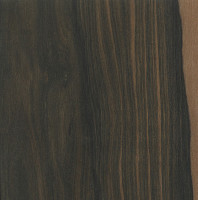
|
Mun Ebony (Diospyros mun)
STATUS: CRITICALLY ENDANGERED One of a handful of ebony species that are native to Asia: more specifically, it’s native to Viet Nam and Laos. Because of exploitation and drastic population reductions, export of this species is currently banned. It is on the IUCN Red List as critically endangered due to a population reduction of over 80% in the past three generations, caused by a decline in its natural range, and exploitation. |
|
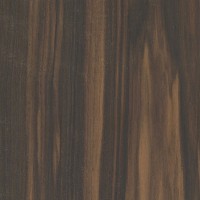 |
Macassar Ebony (Diospyros celebica)
STATUS: VULNERABLE So named for the Indonesian port-city of Makassar, which is one of the primary points of exportation. Being a striped variety of ebony, it is not always considered a direct replacement to African ebony species, and is not considered to be as imperiled as other ebonies. It is on the IUCN Red List as vulnerable due to a population reduction of over 20% in the past three generations, caused by a decline in its natural range, and exploitation. |
|
 |
Wenge (Millettia laurentii)
STATUS: ENDANGERED Wenge is another African hardwood whose natural range largely overlaps that of Gaboon Ebony. Wenge is not related to ebony, but is a very dark wood that turns nearly black when a finish is a applied, and has been considered as a direct replacement to ebony. It is on the IUCN Red List as endangered due to a population reduction of over 50% in the past three generations, caused by a decline in its natural range, and exploitation. |
|
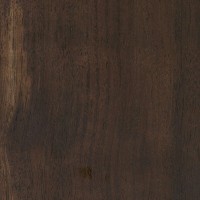
|
Peruvian Walnut (Juglans neotropica)
STATUS: ENDANGERED Perhaps the most fitting name would be Tropical Walnut, yet the term Peruvian Walnut is commonly used among hardwood dealers, even though the wood may not always technically come from Peru. (The name Nogal is also used on occasion, which is Spanish for Walnut.) A number of tropical species in the Juglans genus are on the IUCN Red List. The most notable species, Juglans neotropica, is listed as endangered due to a population reduction of over 50% in the past three generations, caused by a decline in its natural range, and exploitation. |
|
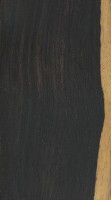 |
African Blackwood (Dalbergia melanoxylon)
STATUS: NEAR THREATENED To be considered the original ebony, African Blackwood was imported and used in Ancient Egypt thousands of years ago. It is reported by the IUCN as being near threatened: technically it doesn’t meet the Red List criteria of a vulnerable or endangered species. However, there’s a great difference between becoming biologically extinct (what the IUCN measures) versus becoming commercially extinct. While not at risk biologically, commercially only ten to twenty percent of mature trees are suitable for exportation, and harvesting is frequently done at an unsustainable rate. |
|
ALTERNATIVES
In some instances, the desire to use true ebony makes sense, but in many cases, the usage of ebony is needlessly perpetuated out of tradition or habit. If you’re considering ebony in a project, ask yourself these questions:
Is the section one solid piece of wood? More than likely you could dye/stain another wood black and achieve a similar appearance at a fraction of the cost. Black-dyed veneers can also be a good choice for some applications. Oak can be ebonized using a solution of steel wool and vinegar, and multiple applications of commercial ebony-colored stains are effective on a wide range of woods as well. When you use stains, you open up a lot more wood species options, and have more flexibility in terms of ease-of-workability, weight, and stability (ebony isn’t the most stable wood around). Examples: piano keys, solid wood furniture.
Does it really have to be wood? The very best and highest grades of ebony are jet-black—free from any traces of color variations, perceptible grain patterns, or imperfections—ironically making it identical in appearance to black plastic. (And chances are, most laypeople and customers unfamiliar with ebony will have no appreciation for the real-deal anyway.) In small accent pieces and inlays, there’s a number of alternative materials, such as (drumroll, please…) plastic. Examples: guitar binding, inlay strips, knobs.
Does it really need to be jet-black? This should be the dagger. Unless you’re specifically doing a Holly-on-Ebony, black-and-white contrast piece, another dark-colored wood would probably do a better job than ebony at complementing the existing colors on a wood project. In most cases, no, the wood doesn’t have to be jet-black. Consider some of these alternative woods (listed below) to add texture, pattern, and/or color variation in your next project.
 |
Katalox (Swartzia spp.)
This is a diamond in the rough. It usually has a lot of sapwood included in most boards. But if you do the math, it’s a very hard, very dark hardwood that costs a lot less than true ebony, even after you account for the waste from the sapwood. It has a pronounced purplish hue, which contrasts yellowish woods well. |
|
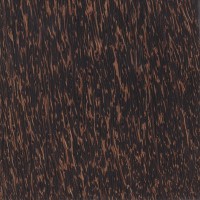 |
Black Palm (Borassus flabellifer)
Black Palm is economical, sustainable, beautiful, and in a lot of instances, would probably serve the same aesthetic function as ebony—and do it in a more organic and natural-looking way. The only downside is that it’s difficult to work with hand or machine tools, and can be very splintery and challenging in its rough, unfinished state. Perfect for single, one-of-a-kind, custom projects. |
|
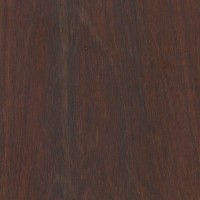 |
Ipe (Handroanthus spp.)
Ipe has a lot of color variation between boards, but darker reddish-brown pieces are available. The wood is dense, strong, and economical, though it does pose challenges in gluing. It’s hard on cutting edges and dulls tools quickly, which should help to give you a behind-the-scenes reminder of what true ebony is really like work with. |
|
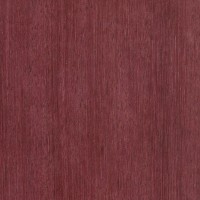 |
Purpleheart (Peltogyne spp.)
There are very dark pieces of Purpleheart available, and the wood becomes even darker once a finish is applied. The vibrant purple color of the wood also tends to darken closer to brown/black with age. Hobbyists have experimented with cooking small pieces of Purpleheart in an oven to naturally darken the color. |
|
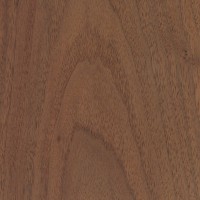 |
Black Walnut (Juglans nigra)
Walnut can lose a lot of color in the kiln-dying process. Air-dried pieces of walnut can have exceptionally rich color with subtle variegations of purple and red mixed within a chocolate-brown background. Not all walnut is created equal, and with a little bit of hunting, some very nice pieces can be found. |
|
 |
Texas Ebony (Ebenopsis ebano)
Texas Ebony can have very dark colors and interesting streaks and grain patterns. However, the wood is quite expensive, and available only in very small sizes. |
|
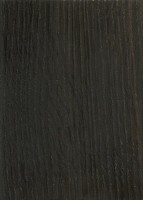 |
Bog Oak (Quercus spp.)
This would be the perfect ebony substitute, except that it’s only produced by natural forces burying the wood in a peat bog for hundreds of years. Given the source (dredged up from swamps), Bog Oak is extremely expensive, and only available in very limited sizes and quantities. |
|
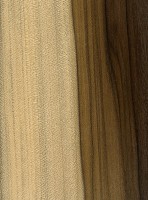 |
Abnormally dark wood: Although not practical on a large-scale production level, many custom furniture makers and other woodworkers would be well served to simply keep their eyes open during their visits to lumberyards and wood suppliers. Spotting some mineral-stained or otherwise abnormally dark wood is a more common occurrence than one might expect. One simple example of this is mineral-stained Yellow Poplar sold at hardware stores, sometimes called Rainbow Poplar. To the left is a picture of Southern Magnolia with some very dark heartwood. | |
-
All About Tonewoods (21)
-
All About Tools (1)
-
Building Electrics (5)
-
Building Skills (11)
-
Driftwood Guitars (6)
-
From The Bench (1)
-
Guitar Building (20)
-
Guitar Maintenance (3)
-
La Due Pragmatic Luthier (7)
-
Guitar Repair (5)
-
Luthier Wisdom (18)
-
Press Releases (4)
-
Schaefer DIY Guitar Making (9)
-
The Builders (72)
-
Workshop Talk (32)















